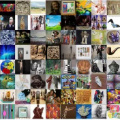Wildlife camera trap images are being used extensively to investigate animal abundance, habitat associations, and behavior, which is complicated by the fact that experts must first classify the images manually. Artificial intelligence systems can take over this task but usually need a large number of already-labeled training images to achieve sufficient performance. This requirement necessitates human expert labor and poses a particular challenge for projects with few cameras or short durations. We propose a label-efficient learning strategy that enables researchers with small or medium-sized image databases to leverage the potential of modern machine learning, thus freeing crucial resources for subsequent analyses. Our methodological proposal is two-fold: (1) We improve current strategies of combining object detection and image classification by tuning the hyperparameters of both models. (2) We provide an active learning (AL) system that allows training deep learning models very efficiently in terms of required human-labeled training images. We supply a software package that enables researchers to use these methods directly and thereby ensure the broad applicability of the proposed framework in ecological practice. We show that our tuning strategy improves predictive performance. We demonstrate how the AL pipeline reduces the amount of pre-labeled data needed to achieve a specific predictive performance and that it is especially valuable for improving out-of-sample predictive performance. We conclude that the combination of tuning and AL increases predictive performance substantially. Furthermore, we argue that our work can broadly impact the community through the ready-to-use software package provided. Finally, the publication of our models tailored to European wildlife data enriches existing model bases mostly trained on data from Africa and North America.
翻译:野生动物摄像机陷阱图像被广泛用于调查动物数量,栖息地关联和行为,并且这还受到专家必须首先手动分类图像的复杂性的困扰。人工智能系统可以接替这项任务,但通常需要大量的已标记训练图像才能实现足够的性能。这个要求需要人类专家劳动力,并对拥有少量相机或短时间的项目构成特别挑战。我们提出了一个标签有效的学习策略,使具有小型或中型图像数据库的研究人员能够利用现代机器学习的潜力,从而为后续分析释放关键资源。我们的方法论提议是双重的:(1)我们通过调整两个模型的超参数来改进当前的目标检测和图像分类组合策略。(2)我们提供一个主动学习(AL)系统,允许非常有效地训练深度学习模型,因为需要的人工标记的训练图像数量较少。我们提供一个软件包,使研究人员可以直接使用这些方法,从而确保所提出的框架在生态实践中的广泛适用性。我们展示了我们的调优策略可以提高预测性能。我们展示了AL管道减少了实现一个特定的预测性能所需的预标记数据的数量,并且它在提高防止过拟合预测性能方面特别有价值。我们得出结论,调整和AL的结合大大增加了预测性能。此外,我们认为我们的工作可以通过提供现成使用的软件包广泛影响社区。最后,我们针对欧洲野生动物数据量身定制的模型的出版丰富了主要在非洲和北美的数据的现有模型库。



